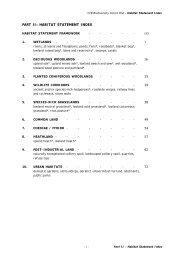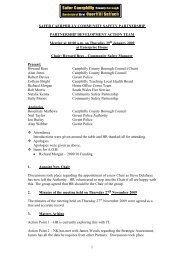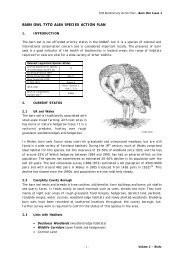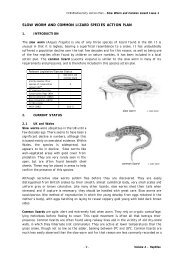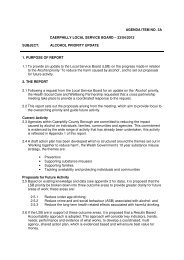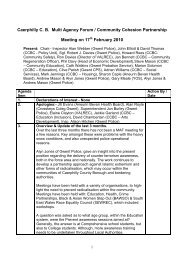LONG-EARED OWL ASIO OTUS SPECIES ACTION PLAN
LONG-EARED OWL ASIO OTUS SPECIES ACTION PLAN
LONG-EARED OWL ASIO OTUS SPECIES ACTION PLAN
You also want an ePaper? Increase the reach of your titles
YUMPU automatically turns print PDFs into web optimized ePapers that Google loves.
CCB Biodiversity Action Plan – Long-eared Owl Issue 1<strong>LONG</strong>-<strong>EARED</strong> <strong>OWL</strong> <strong>ASIO</strong> <strong>OTUS</strong> <strong>SPECIES</strong> <strong>ACTION</strong> <strong>PLAN</strong>1. INTRODUCTIONAlthough it is not a priority species in the UKBAP, the long-eared owl is a UK species ofconservation concern 39 and is of importance locally.Relevant Legislation/Species Statuspriority species (P) orspecies of conservationconcern (S)EC Birds Directive 1979 -Berne Convention 1982 Appendix IIBonn Convention 1979 -CITES 1975SAnnex AWCA 1981 Part I, Section 1Birds of ConservationConcern List 30 -2. CURRENT STATUS2.1 UK and WalesThe long-eared owl is a nocturnal hunter andfeeds mainly on small mammals andoccasionally on small birds. It hunts overconiferous and, sometimes, deciduouswoodlands and their margins.© CCBC 2002There is a population increase in the winter months as migrant birds from the colder regions ofEurope arrive in Britain. It is often seen in communal winter roosts in low scrub trees and youngconifers. It breeds mainly in old woodland corvid nests, in both coniferous and deciduouswoodlands. Breeding populations of the long-eared owl are contracting and declining, withnumbers estimated at 2,000 – 2,500.2.1 Caerphilly County BoroughIn the Gwent/Glamorgan area the main nesting habitat is thicket/early mature stage conifersand the hunting habitats are coedcae/ffridd, rhos pasture, upland heath and re-stock areas.There is one recent record of the long eared owl in Caerphilly county borough around Cwmcarn,and a historical record from Wern Ddu. The species is thought to be under-recorded because ofits nocturnal habit and is easily overlooked. More survey work is required.2.2 Links with Habitats• Planted Coniferous Woodlands• Deciduous Woodlands• Species-rich Grasslands (rhos pasture)• Coedcae/ffridd• Heathland (upland heath)- 53 - Volume 2 - Birds
CCB Biodiversity Action Plan – Long-eared Owl Issue 13. CURRENT FACTORS AFFECTING THE <strong>SPECIES</strong>• Loss of foraging areas is one of the main factors affecting the long-eared owl, for exampleloss of rough grasslands through excessive cutting.• Over-use of rodenticides and pesticides.4. CURRENT <strong>ACTION</strong>4.1 Many SINC sites have been designated which contain woodland habitat suitable tosupport long-eared owls 8 .4.2 The Gwent Ornithological Society and Glamorgan Bird Club gather information from itsmembers on the distribution of long-eared owls and other birds, and both bodies publishannual bird reports 17, 18, 19 .4.3 BTO's Breeding Bird Survey contributes to regular monitoring of breeding population 6 .5. OBJECTIVES AND TARGETS5.1 UK Objectives and TargetsNot applicable to this species.5.2 Caerphilly Objectives and Targets5.2.1 Identify and maintain current breeding numbers, and continue survey work to identifynew breeding areas. (Target: ongoing)5.2.2 Protect important breeding and roosting sites. (Target: ongoing)6. <strong>ACTION</strong> AND KEY PARTNERSActionKey Partners6.1 Policy and LegislationNone proposed at this time. - -6.2 Site Safeguard and Management6.2.1 Maintain the current extent andquality of breeding and roosting sites,especially in coniferous woodlands,through appropriate management.6.2.2 Maintain and seek to enhance thecurrent extent of hunting habitatsthrough sympathetic management ofrhos pasture, ffridd and upland heath.6.3 Species Management and Protection6.3.1 Seek to create new nesting sitesby providing nest baskets andsafeguarding areas of conifer thicket.Year to be complete or in place by:Lead Partners 2003 4 5 6 7 8 9 10 11FCCCBCW<strong>OWL</strong>SCCBC, GWT,GLWTlandownersGWT GLWTlandownersFC GWTGLWT CCBCü ü ü ü ü ü ü ü üüü- 54 - Volume 2 - Birds
CCB Biodiversity Action Plan – Long-eared Owl Issue 1ActionKey Partners6.3 Species Management and Protection (continued)6.3.2 Continue to implement wildlifelegislation.6.4 Advisory6.4.1 Produce advisory material forlandowners and other interestedparties, about the requirements of thespecies and sympathetic managementof habitats.6.4.2 Disseminate information aboutringing of owlets and the monitoring ofnest sites to interested parties.6.5 Future Research and Monitoring6.5.1 Monitor nest and roost sitesannually, marking young owlets6.6 Communications and Publicity6.6.1 Encourage membership of wildlifetrusts and local ornithologicalsocieties.6.6.2 Provide schools and colleges inthe county borough with information inorder to educate children, parents andteachers about the conservation statusof owls in the local area.6.6.3 Use all relevant publicity materialto discourage the use of insecticidesand rodenticides.Year to be complete or in place by:Lead Partners 2003 4 5 6 7 8 9 10 11GwentPoliceCBP - ü- ü ü ü ü ü ü ü ü üW<strong>OWL</strong>S - ü ü ü ü ü ü ü ü üW<strong>OWL</strong>SCBPCBPGBC GOSBTOGWT GLWTGBC GOSCCBC SchoolsYouth ForumW<strong>OWL</strong>Sü ü ü ü ü ü ü ü üü ü ü ü ü ü ü ü üüCBP - ü ü ü ü ü ü ü ü üü- 55 - Volume 2 - Birds



